|
Past Articles
ADD
Asthma and Allergies
Asthma and Chiropractic
Celiac Disease
Children and Car Accidents
Cold and Flu "Season"
Comparing Chiropractic, Drugs, and Accupuncture
Do you know these names?
Feet support, so they support you
Fun with words
Heel Spurs/Plantar Fascitis
How serious are slow car accidents?
Immunity and Chiropractic
Indigestion/Heartburn
Infants, Birth, and Chiropractic
Masha and Dasha
Morton's vs. Metatarsalgia
Movement and Spinal Health
Once You Go . . .
Paradigm Shift
Safety of Chiropractic
Scoliosis
Selling Disease
Shin Splints
Sinusitis
Studies on Chiropractic
Sweetners: are they sweet for your body?
Tarsal Tunnel Syndrome
Training for Life
Virus-"Killer" Salsa
Want to save some money this year?
What age?
Whiplash
Comparing Chiropractic, Drugs, and Accupuncture
The following is an abstract from the Journal of Spine (the premier journal for spinal conditions). I've highlighted the important points below, but basically it shows how chiropractic patients responded the quickest and were pain-free for the longest. Actually, a follow up study 18 months later found that patients under Chiropractic care continued to have positive benefits. The college conducting the study stopped it because they didn't want Chiropractic to get such great press in the best journal for spinal conditions. What this abstract didn't include is that the 2 medications used were Celebrex and/or Vioxx.
Abstract:
Study Design. A randomized controlled clinical trial was conducted.
Objective. To compare medication, needle acupuncture, and spinal manipulation for managing chronic (>13 weeks duration) spinal pain because the value of medicinal and popular forms of alternative care for chronic spinal pain syndromes is uncertain.
Summary of Background Data. Between February 1999 and October 2001, 115 patients without contraindication for the three treatment regimens were enrolled at the public hospital's multidisciplinary spinal pain unit.
Methods. One of three separate intervention protocols was used: medication, needle acupuncture, or chiropractic spinal manipulation. Patients were assessed before treatment by a sports medical physician for exclusion criteria and by a research assistant using the Oswestry Back Pain Disability Index (Oswestry), the Neck Disability Index (NDI), the Short-Form-36 Health Survey questionnaire (SF-36), visual analog scales (VAS) of pain intensity and ranges of movement. These instruments were administered again at 2, 5, and 9 weeks after the beginning of treatment.
Results. Randomization proved to be successful. The highest proportion of early (asymptomatic status) recovery was found for manipulation (Chiropractic adjustments) (27.3%), followed by acupuncture (9.4%) and medication (5%). Manipulation achieved the best overall results, with improvements of 50% (P = 0.01) on the Oswestry scale, 38% (P = 0.08) on the NDI, 47% (P < 0.001) on the SF-36, and 50% (P < 0.01) on the VAS for back pain, 38% (P < 0.001) for lumbar standing flexion, 20% (P < 0.001) for lumbar sitting flexion, 25% (P = 0.1) for cervical sitting flexion, and 18% (P = 0.02) for cervical sitting extension. However, on the VAS for neck pain, acupuncture showed a better result than manipulation (50%vs 42%).
Conclusions. The consistency of the results provides, despite some discussed shortcomings of this study, evidence that in patients with chronic spinal pain, manipulation (Chiropractic adjustments), if not contraindicated, results in greater short-term improvement than acupuncture or medication. However, the data do not strongly support the use of only manipulation, only acupuncture, or only nonsteroidal antiinflammatory drugs for the treatment of chronic spinal pain. The results from this exploratory study need confirmation from future larger studies.
Source:
Chronic Spinal Pain: A Randomized Clinical Trial Comparing Medication, Acupuncture, and Spinal Manipulation.
Spine. 28(14):1490-1502, July 15, 2003.
Giles, Lynton G. F. DC, PhD; Muller, Reinhold PhD
back to top
Morton's vs. Metatarsalgia
Morton’s Interdigital Neuroma
Although this painful foot condition has nothing to do with salt, it does affect the flavor and quality of the person’s life who has this problem.
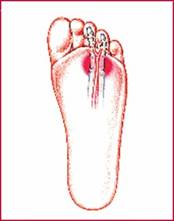 The interlocking mechanism of the midfoot bones maintains the Transverse Metatarsal arch (top of foot), and allows for the proper function of the foot and its soft tissues. When the foot bones become misaligned (due to trauma, prolonged standing, or poor fitting shoes) the bones can compress the small sensory nerves between the toes, usually between the 2nd and 3rd, or 3rd and 4th toes, causing pain and swelling between the toes. The interlocking mechanism of the midfoot bones maintains the Transverse Metatarsal arch (top of foot), and allows for the proper function of the foot and its soft tissues. When the foot bones become misaligned (due to trauma, prolonged standing, or poor fitting shoes) the bones can compress the small sensory nerves between the toes, usually between the 2nd and 3rd, or 3rd and 4th toes, causing pain and swelling between the toes.
Specific Chiropractic adjustments to the appropriate foot bones has been found to be very effective in correcting this painful and debilitating condition.
It is important to find a Chiropractor who specializes in the care of foot and ankle problems (as well as the spine). Here at Camp Chiropractic we have helped many people find relief and correction for this problem, without the use of drugs and surgery. Never been to a Chiropractor? Come talk with one of the doctors about your condition. We care about how you feel!
Metatarsalgia
This painful foot condition can be distinguished from Morton’s by using a simple test, discussed in a moment. The pain associated with Metatarsalgia is pain at the base of the toes that is worse when walking as you push off with the toes, and typically is relieved by standing still (this aggravates Morton’s). To determine which condition you my have follow this simple test: squeeze your foot, trying to compress your big toe toward your little toe, if this causes pain it is likely Morton’s. If no pain occurred then palpate/feel over the base of the toes, if pressure to the toe bones causes pain then the likely diagnosis is Metatarsalgia. Both of the conditions can result from abnormal foot bone position and mechanics. A specially trained doctor of Chiropractic can carefully correct the misalignment of the feet and allow you to return to your normal lifestyle, pain free!
Stop suffering from the agony of DA-FEET!!!
back to top
Tarsal Tunnel Syndrome
Similar to Carpal Tunnel Syndrome of the wrist, this condition is most prevalent among runners, but may occur in skiers, surfers, construction workers, or anyone who spends significant time on their feet.
Tarsal Tunnel Syndrome (T.T.S.) is nerve entrapment on the medial side of the foot which results in medial heel and arch pain, and is typically aggravated by running. Contrast to Plantar Fascitis pain which occurs on the bottom of the heel bone, at the origin of the Plantar Fascia, and improves with stretching or running.
 What could cause the nerves to become compressed? Any condition which decreases the narrow space through which the nerve passes. For example, Rheumatoid Arthritis, Osteoarthritis, Diabetes, Flat Feet (Pronation), Fractures, leaking silicon breast implants, and trauma. However, the most common cause of T.T.S. is biomechanical dysfunction of the foot and ankle complex (Jackson DL, Haglund BL: Tarsal Tunnel Syndrome in runner. Sports Med. 1992; 13:146-49). Foot bones which move out of the proper alignment resulting in nerve compression and pain. What could cause the nerves to become compressed? Any condition which decreases the narrow space through which the nerve passes. For example, Rheumatoid Arthritis, Osteoarthritis, Diabetes, Flat Feet (Pronation), Fractures, leaking silicon breast implants, and trauma. However, the most common cause of T.T.S. is biomechanical dysfunction of the foot and ankle complex (Jackson DL, Haglund BL: Tarsal Tunnel Syndrome in runner. Sports Med. 1992; 13:146-49). Foot bones which move out of the proper alignment resulting in nerve compression and pain.
Treatment for this condition would be to address the faulty biomechanics of the ankle, foot, knee, pelvis, and spine to allow a comprehensive care approach rather than treat the symptoms through drugs and surgery. 80% of the individuals who have Tarsal Tunnel Syndrome respond to conservative treatment in 6-8 weeks by realigning the bones, exercises, and orthotics may be used in cases of flat feet.
If you or someone you know is suffering needlessly call our office to set up an appointment to get back on your feet.
The information above is yours, the information below is ours!
back to top
Feet support, so they support you
Have you heard of foot inserts? Inserts are those soft pads by Dr.  Scholl’s that you can get at Wal-Mart that are supposed to cushion your shoes. How about orthotics? Orthotics are custom inserts that are designed to support the arches of your foot and support foot mechanics. Do you know there is a big difference between orthotics from a podiatrist and those from a chiropractor? There is and here is just a short list of the differences: Scholl’s that you can get at Wal-Mart that are supposed to cushion your shoes. How about orthotics? Orthotics are custom inserts that are designed to support the arches of your foot and support foot mechanics. Do you know there is a big difference between orthotics from a podiatrist and those from a chiropractor? There is and here is just a short list of the differences:
Flexible—Foot Levelers (custom designed in our office)
- Designed to influence the joint receptors and evoke positive proprioceptive response from the cerebellum, resulting in better muscle balance.
- Does not create any hypermobile joints above the ankle.
- Designed to provide a balanced foundation for the foot and spine.
- Custom fitted from a mold of your foot while standing (the position most important for support)
Rigid—Podiatrists
- Designed in a way rarely evoking positive proprioceptive response; in fact, generally evokes a negative response.
- Restricted motion in the foot can create hypermobility in joints above the ankle.
- Designed to maintain a rigid neutral position of the foot, thereby forming a crutch effect—muscle weakness can result.
- Often fitted from a mold of your foot when laying down (this is more convenient for the podiatrist)
You have 4 arches in each of your feet designed to flex and stretch. This is so that your body is cushioned from walking and standing. Prolonged standing on hard surfaces leads to fatigue of these arches and is why many factories require mats for workers. Does it make sense to put a hard surface underneath your feet? A good orthotic is designed to work with your feet to make them stronger.
Often a foot misalignment can lead to problems further up the body and is why we check the feet in our office. It’s also important to have your foot adjusted before casting for a foot support so that your orthotics will be built to hold you in the proper position. If you have any questions about how orthotics may be right for you, please ask! The information above is yours, the number below is ours.
back to top
How serious are slow car accidents?
 I have been asked many times by patients, “Why am I hurting so bad when there wasn’t any damage to my car when I was rear-ended? The insurance company said I couldn’t possibly be hurt because the other driver was only going 10 mph.” To answer this question you must understand some things about human anatomy and current research. The neck is the most vulnerable part of the spine in an auto accident and especially in rear-end collisions. I have been asked many times by patients, “Why am I hurting so bad when there wasn’t any damage to my car when I was rear-ended? The insurance company said I couldn’t possibly be hurt because the other driver was only going 10 mph.” To answer this question you must understand some things about human anatomy and current research. The neck is the most vulnerable part of the spine in an auto accident and especially in rear-end collisions.
It has been known for over 50 years that an individual is more likely to have permanent spinal damage as a result of being hit from behind than from any other impact direction. Nikoli Bogduk, M.D., the most prominent author on whiplash injury states, “5 mph is the threshold for symptomatic injury”. In other words, you only have to be going 5 mph to experience an injury and anything greater increases your chances for long term problems.
Research has also found that the spinal cord of monkeys could be torn in half by an impact of only 11 mph, and that an 8 mph rear-end accident could generate 12 G’s of force on the head and neck (more force than a fighter pilot experiences). The result is nerve root tearing and bleeding, joint damage, ligament and muscle tearing, and disc injury. Adults and children can end up with spinal problems that, if uncorrected, will cause long term disabilities and accelerate spinal decay. Symptoms may take weeks or even months to appear, so you can’t rely on pain to notify you of the problem.
It is now known that spinal care which begins immediately after a whiplash accident will help the spine heal faster, stronger, and reduce long term spinal pain or disability. Chiropractic care is covered by auto insurance plans having PIP (Personal Injury Protection) coverage and will also cover children hit by cars while bicycling, skateboarding, or walking. If you’re not sure what is covered, give us a call and we will check on it for you.
If you have been in an accident don’t wait. Have your spine checked now. Early correction means early prevention. The information above is yours, the number below is ours.
back to top
Fun with words
How would you like it if you had a lot of pain in your shoulder, you asked a friend to look at it, and he simply told you that you had pain in your shoulder? Seems kind of redundant doesn’t it?
 Or what if he gave it a fancy name? Like bursitis. If you break that word down, you come up with bursitis = “bursa” + “itis”. A bursa is a fluid filled sac that is in your shoulder (there are bursa in other places in the body as well) and “itis” means inflammation. Well, inflammation is pretty much the same thing as pain because inflammation produces pain. So we’re back to square one. When you’re friend tells you that you have bursitis, it’s like saying you have pain in your shoulder. He’s told you what you already know. Or what if he gave it a fancy name? Like bursitis. If you break that word down, you come up with bursitis = “bursa” + “itis”. A bursa is a fluid filled sac that is in your shoulder (there are bursa in other places in the body as well) and “itis” means inflammation. Well, inflammation is pretty much the same thing as pain because inflammation produces pain. So we’re back to square one. When you’re friend tells you that you have bursitis, it’s like saying you have pain in your shoulder. He’s told you what you already know.
So what is my point with all of this word fun? Simply that putting a name on something does not solve the problem. We often put names on different things like fibromyalgia, cancer, heart burn or acid reflux, allergies, asthma, headaches, back pain, constipation, ear infection, sinus congestion, etc. That’s great to identify the symptoms, but it is more important to find the source of the problem. All of the conditions I named above are due to dysfunction in the body because something is not working right. And although many of them are common, that does not mean it’s normal.
So now that we’ve identified the shoulder problem and given it a fancy name, what do you do? Cover up the pain of the shoulder with medication or reduce what is causing the inflammation of the bursa? I’ll leave that answer up to you, but while you think about that, remember this: the power that made the body heals the body!
If you think this information would be useful for someone else, please ask us for a copy. Also, if you are interested in more articles just like this one, please check out our website at www.campchiro.com. The information above is yours, the number below is ours.
back to top
Training for Life
If you had to go out and run a marathon tomorrow, could you do it? Most people  probably couldn’t, but that’s because you have to train your body to be able to run for 26 miles without stopping. However that takes time; time for the muscles to grow, time for the ligaments to stretch, and time for the blood vessels to get used to increased work load. So why do we think we can do years of damage to our bodies and expect to fix the problem quickly? We can’t! All healing, building, and retraining of the body takes time. It has been said before and it’s still true: “Anything worth doing takes time”. probably couldn’t, but that’s because you have to train your body to be able to run for 26 miles without stopping. However that takes time; time for the muscles to grow, time for the ligaments to stretch, and time for the blood vessels to get used to increased work load. So why do we think we can do years of damage to our bodies and expect to fix the problem quickly? We can’t! All healing, building, and retraining of the body takes time. It has been said before and it’s still true: “Anything worth doing takes time”.
Speaking of running marathons, exercise is a great way to maintain a healthy body. Studies show that exercise lowers chance of: heart problems, cancer (colon, breast, and prostate), ulcers, mental deterioration, Alzheimer’s, depression, complications in pregnancy, cholesterol, and diabetes. Wow! Not only does exercise help you in those areas, but people who exercise typically eat well due to the change in lifestyle. So this shows that exercise is preventative as well as strengthening.
 Exercise obviously builds muscle, but do you know what muscle does? It actually has a lot more functions than to make you look like Arnold Schwarzenegger. Muscle is used to store nutrients and toxins, provide movement for the skeletal system, and support hard and soft tissue of the body. It is one of the quickest responding tissues in the body. This means that muscle is one of the things that will change the most in the shorter period of time. Exercise obviously builds muscle, but do you know what muscle does? It actually has a lot more functions than to make you look like Arnold Schwarzenegger. Muscle is used to store nutrients and toxins, provide movement for the skeletal system, and support hard and soft tissue of the body. It is one of the quickest responding tissues in the body. This means that muscle is one of the things that will change the most in the shorter period of time.
This does not mean that everyone needs to run marathons to be healthy. Actually, doing something as simple as parking your car further away from the grocery store can be a way you begin to incorporate more exercise. You could even go for a walk around the neighborhood. It doesn’t matter what it is, as long as you take the first step (because the first step is usually the hardest).
Have you ever heard the phrase: today is the first day of the rest of your life? Well it’s true! You can’t go back to yesterday to finish that project, you can’t get rid of that ice cream sundae that you had to have, you can’t undo that fall you had, and you can’t even go back and exercise to make up for the past week that you forgot. Today is a new opportunity, how will you use it? Let this article be the starting point to a new lifestyle as you train for your life.
We are always available to answer questions about exercise programs and as soon as you’re ready to start, we’re ready to help. The information above is yours, the number below is ours.
back to top
Want to save some money this year?
 I don’t know about the rest of you, but around tax time I tend to look a little closer at my finances. As you go over your W-2’s and all those receipts, it gives you a chance to see where all the money goes. Included in the returns is an area to report how much you spend on health care, including insurance, drugs, and physician visits. It’s interesting to see how quickly it adds up. So this got me thinking, how much does it cost to go to the Chiropractor? Or, how much do I save? I don’t know about the rest of you, but around tax time I tend to look a little closer at my finances. As you go over your W-2’s and all those receipts, it gives you a chance to see where all the money goes. Included in the returns is an area to report how much you spend on health care, including insurance, drugs, and physician visits. It’s interesting to see how quickly it adds up. So this got me thinking, how much does it cost to go to the Chiropractor? Or, how much do I save?
So I dove into the current research and found some impressive results. Did you know the British Medical Journal, the premier medical journal, states that:
Spinal manipulation is a cost effective addition to best care for back pain in general practice. Manipulation alone probably gives better value for the money.
BMJ Dec 11, 2004 |
The study examined 1287 patients for a year and found that quality of life was improved with adjustments while at the same time saving money. Sounds like a Happy Meal value to me!
 In a separate study, the Archives of Internal Medicine found that Chiropractic patients had lower annual total health care expenditures (Arch Intern Med 2004). Actually, they saved an average of $208 a year. Back pain patients with Chiropractic insurance coverage had less x-rays taken, low back surgery, hospitalization, and magnetic resonance imaging (MRI). Meaning more money for the Chiropractic patient’s pocket! So when those tax returns come back think of investing it in your Chiropractic care for this year. In a separate study, the Archives of Internal Medicine found that Chiropractic patients had lower annual total health care expenditures (Arch Intern Med 2004). Actually, they saved an average of $208 a year. Back pain patients with Chiropractic insurance coverage had less x-rays taken, low back surgery, hospitalization, and magnetic resonance imaging (MRI). Meaning more money for the Chiropractic patient’s pocket! So when those tax returns come back think of investing it in your Chiropractic care for this year.
Remember, regular, consistent Chiropractic care is preventative (like taking your daily multivitamin to ensure that your body is getting the proper nutrients). It should be part of your wellness lifestyle and it’s a great way to save money while staying healthy. The information above is yours, the number below is ours.
back to top
Do you know these Names?
 Do the names Jerry Ramageda, Tom LaFountain, or Jeffrey Spencer ring a bell to you? If not you are probably not alone, but perhaps you are more familiar with the teams and individuals they’re associated with. These men are the past and present Doctors of Chiropractic for the Seattle Seahawks, Tiger Woods, and Lance Armstrong respectively. Chiropractic is becoming so well known for its preventative health benefits that these athletes and many others are among the growing list of individuals who attribute their athletic success to Chiropractic. Do the names Jerry Ramageda, Tom LaFountain, or Jeffrey Spencer ring a bell to you? If not you are probably not alone, but perhaps you are more familiar with the teams and individuals they’re associated with. These men are the past and present Doctors of Chiropractic for the Seattle Seahawks, Tiger Woods, and Lance Armstrong respectively. Chiropractic is becoming so well known for its preventative health benefits that these athletes and many others are among the growing list of individuals who attribute their athletic success to Chiropractic.

Maintaining proper biomechanical function in the spine is essential to the success of these elite athletes. When any loss of balance and coordination can make the difference between a tournament victory and a second place finish, Chiropractic is being shown to help in keeping top-level athletes functioning at their best. Even “The Governator” himself, Arnold Schwarzenegger, has spoken at several International Chiropractic Association meetings about the natural health benefits of Chiropractic care in relation to sports, bodybuilding, and fitness.
When it comes to your health, don’t be passive. Take an active role in learning about what you can to maintain and maximize your health potential before health problems occur. Everyone from the weekend warrior to the most elite professional athlete can benefit from preventative Chiropractic care. Consult your Chiropractor today and ask to learn more about how Chiropractic helps to keep your spine and nervous system functioning at an optimal level.
Also, not all Chiropractors are the same. There are those who examine and adjust the extremities, and those who don’t. Since athletes tend to put more stress on the extremities on a daily basis, we find it important to examine both the spine and the extremities in our office. We also believe in tailoring a specific exercise program for each individual. We know how much you can achieve when you are involved in your health care. Call us today to find out how we can help you achieve both your personal and athletic goals!
back to top
Heel Spurs/Plantar Fascitis
The foot is a flexible, functional device that is structured to provide body support, aid in ambulation/walking, absorb foot impact forces, allow for adaptation on uneven surfaces, and is the foundation on which the body stabilization is built. It is made up of 26 bones, has 4 arches, over 100 ligaments, and is supported by incredibly strong muscles and fascia.
The integrity of the knee, hip, and lower spine depends upon proper “function” of the ankle mortise, hind foot, mid foot, and forefoot. So basically, if the foot malfunctions then the forces which would normally be absorbed in the arches and joints of the lower extremity becomes transmitted to the soft tissue. For example, an ankle sprain (stretching or tearing of ligaments, ligaments connect bone to bone) occurs when the bones separate, and is unable to pull those misaligned bones back together. Due to increased stress on the already stretched ligaments the misaligned bones make you susceptible to re-spraining the ankle. As you begin running and playing, the ankle is unable to absorb the impact forces, therefore, the plantar fascia (bottom of foot) either becomes inflammed resulting in Plantar Fascitis, or the fascia begins tugging on the heel bone causing a heel spur.
Is the answer to cut the heel spur off or inject the area with steroids? Or would it be more prudent to realign the bones, take pressure off the fascia, and restore mechanical stability to the foot, thus allowing the body to heal itself?
How can a Chiropractor help? Since the nervous system controls the entire function of the body, if there is an improper or weak nerve supply from the spine to the lower leg, the supporting tissue will be weak and result in a sprain or mechanical imbalance. However, if it is misaligned foot bones, a Chiropractor that understands foot mechanics will adjust the bones into a normal position, allowing the body to strengthen and heal.
The information above is yours, the information below is ours.
back to top
Shin Splints
Many athletes suffer from this condition of the lower leg, that destroys the training schedule, affects running speed, and begins to cause postural distortions to the hips, spine, shoulders, and even head posture.
Symptoms of Periostitis, more commonly called Shin Splints, begin in the lower 1/3 of the leg on the lateral side of the tibia or shin bone and may feel like an achy or tight sensation. As you begin running there is an increase of pain which may be sharp and pulling in nature which improves as you warm-up and becomes worse as you cool down. Many athletes find that they experience this when they go from a soft to a hard surface, increase their training distance, or increase training intensity/frequency.
What is the cause? According to the American Academy of Orthopedic Surgeons Symposium on foot and ankle injuries the most common cause is a “widening of the ankle mortise . . .” So what causes this widening? Let’s look at the ankle anatomy.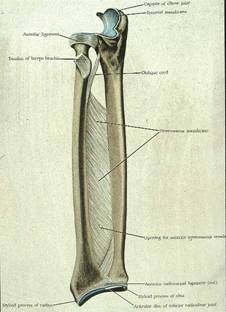
The interosseous membrane connects the tibia to the fibula (the two bones of the lower leg). It has some flexibility to stretch but remains somewhat rigid. Ankle sprains cause the Talus bone to misalign which results in spreading the tibia and fibula, tugging on the interosseous membrane, each time the foot hits the ground. These little “contraction tugs” cause the periosteum (outer layer of bone) to become inflammed, thus, Periostitis!
The Solution: re-align the ankle bones, foot bones, tibia, spine, or other joints to allow the area to heal, and most athletes return to normal activity in 2-4 weeks (usually sooner).
The information above is yours, the information below is ours.
back to top
Celiac disease
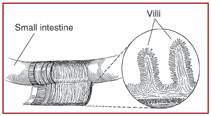 Celiac disease is a digestive disease that damages the small intestine and interferes with absorption of nutrients from food (aka sprue). People who have celiac disease cannot tolerate a protein called gluten, found in wheat, rye, and barley. Celiac disease is a digestive disease that damages the small intestine and interferes with absorption of nutrients from food (aka sprue). People who have celiac disease cannot tolerate a protein called gluten, found in wheat, rye, and barley.
When people with celiac disease eat foods or use products containing gluten, their immune system responds by damaging the small intestine. The tiny, fingerlike protrusions lining the small intestine are damaged or destroyed. Called villi, they normally allow nutrients from food to be absorbed into the bloodstream. Without healthy villi, a person becomes malnourished, regardless of the quantity of food eaten.
According to various sources, celiac disease can be linked to schizophrenia (British Medical Journal), tumors (American Journal of Medicine), osteoporosis, infertility, a history of miscarriages, and an increased chance of fractures. Because the symptoms are so varied, it is often misdiagnosed or over-looked as a problem.
There are ways to detect celiac disease by biopsy, but an easier test is to try a gluten-free diet. After a few weeks on the diet, most people notice their symptoms decrease if they have the disease (some even notice improvement in a couple of days). The small intestine is usually completely healed in 3 to 6 months in children and younger adults and within 2 years for older adults. This means that the intestines can then absorb nutrients into the bloodstream again.
So what is a gluten-free diet? Basically foods like wheat, barely, and rye. But there are many more foods that include some form of those grains and it’s best to either talk to a nutritionist or look up “gluten-free” diet online. One word of caution, there is a lot of information on the web that is not always accurate, so it is always best to consult with your doctor about the diet you are using.
You’ll also notice that celiac disease “interferes” with absorption, but what interferes with the small intestine and makes the immune system overreact in the first place? Since the nervous system controls both, it makes sense to check for interference of the nerve supply too. That’s exactly what checking for subluxations of the spine is all about! Don’t know what a subluxation is? Just ask us! The information above is yours, the information below is ours.
back to top
Cold and Flu "Season"
“Every function of the human body is under control of the nervous system” -Grays Anatomy, 29th edition, p. 4
Have you heard of cold and flu season? There are several things you can do to help your body 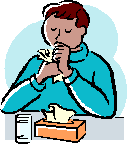 out during this “season”. First is a good diet. To have a healthy immune system you must avoid refined sugar, white flour, deep-fried foods, chemical additives, and hydrogenated oils. You also want to consume enough fruits and vegetables and drink enough water. In fact, try dropping all soda and flavored drinks for one month. The difference will astound you! Truth is, there really is no season for cold and flu. However there is a time of year where people’s immune system is depressed due to holiday stress, changes in eating habits, changes in sleep patterns, and changes in weather patterns. out during this “season”. First is a good diet. To have a healthy immune system you must avoid refined sugar, white flour, deep-fried foods, chemical additives, and hydrogenated oils. You also want to consume enough fruits and vegetables and drink enough water. In fact, try dropping all soda and flavored drinks for one month. The difference will astound you! Truth is, there really is no season for cold and flu. However there is a time of year where people’s immune system is depressed due to holiday stress, changes in eating habits, changes in sleep patterns, and changes in weather patterns.
There are also suppliments that can boost your immune system. Bio-Immunozyme Forte, IAG, Bio-C Plus, Bio-AE-Mulsion Forte, and A.D.P to name a few. These are products made by Biotics carried in our office that strengthen the immune system. The following explains each of these products.
Bio-Immunozyme Forte: This is a multi-vitamin that contains glandulars to boost immunity and has a base of Echinacea.

IAG: Comes from the Western Larch tree that contains similar properties as herbs that boost immunity like echinacea and golden seal. It actually contains Arabinogalactans which are long chain sugars that are well-tolerated by children and adults.
Bio-C Plus: This contains several mixed forms of ascorbate (Vit. C) that is good for the immune system and is less likely to cause digestive distress than ascorbic acid.
Bio-AE-Mulsion Forte: Vitamin A is useful for membrane integrity and helps boost immune function. Infections deplete vitamin A stores. Bio-AE-Mulsion has 12,500 I.U. of Vitamin A per drop to restore normal levels in the body.
A.D.P.: This is an extract of oregano that is an excellent antimicrobial, which is great for upper respiratory infections and sinusitis (sinus infections).
These are just a few of the fine products that we carry to help support your body’s health. They can be used in different combinations, to find out which, just ask! Remember, health comes from the inside out, not outside in.
back to top
News Flash: Motion is Life!
Maybe you’ve heard it said before, but it never hurts to hear it again. Movement is what keeps your spine healthy and functioning at 100%. And chiropractors aren’t alone on this. Dr. Mooney (M.D.) stated in the Journal of Musculoskeletal Medicine that, “Since the disc lacks blood flow, enhanced fluid exchange is the only mechanism for improved cellular nutrition and removal of byproducts”.
 What this is saying is that your discs (the cartilage shock absorbers of the spine that allow the bones to move) don’t have a good blood supply. Blood is what carries nutrients like oxygen and vitamins to most tissues. Discs, however, get their nutrients much like a sponge takes in more water when it is squeezed and released. This process is called imbibation. Moving spinal joints and discs cause fluids and nutrients to flow into the disc and removes the garbage like inflammation byproducts. Just like ligaments that are torn, damaged discs take longer to heal than other tissues in the body because imbibation is a slower process than blood flow. So movement, including chiropractic adjustments, walking around the block, or running a marathon, is good for your spine! What this is saying is that your discs (the cartilage shock absorbers of the spine that allow the bones to move) don’t have a good blood supply. Blood is what carries nutrients like oxygen and vitamins to most tissues. Discs, however, get their nutrients much like a sponge takes in more water when it is squeezed and released. This process is called imbibation. Moving spinal joints and discs cause fluids and nutrients to flow into the disc and removes the garbage like inflammation byproducts. Just like ligaments that are torn, damaged discs take longer to heal than other tissues in the body because imbibation is a slower process than blood flow. So movement, including chiropractic adjustments, walking around the block, or running a marathon, is good for your spine!
Here are a few more things motion/exercise does for you:
- increases range of motion
- stimulation of spinal injury healing with less scar tissue
- improved stability and strength
- improves coordination and balance
Who do you know that needs chiropractic? Refer them today!
back to top
Children and Chiropractic
FACT: The birth process is a cause of Vertebral Subluxation Complexes (VSC).
Abraham Towbin, M.D.(1965) - Sudden infant crib death is caused by spine damage to the nerve system (VSC) during the birth process.
Floyd Gilles (Harvard Researcher)(1979) - 7 of 8 autopsies showed this (VSC) to be the cause of deaths in SIDS victims.
David Yashon, M.D. - Confirms Towbin’s findings and reports that the delivery process is a cause of spinal injury with nerve damage. 10% of infants’ deaths are due to this.
J. M. Duncan, M.D. - 90 lbs. of pull (force) can cause decerebration (separation of brain and spinal cord). This amount of force is not considered a lot of pull by M.D.’s.
G. Gutmann, M.D. - 80% of the children he examined shortly after birth, or as infants, were suffering from a subluxation of the first bone in the neck, causing all manner of diseases.
T. Videman, M.D., Institute of Occupational Health, Helinski, Finland - Permanent joint degeneration from hypomobility (VSC) begins within a few weeks (10 days) . . . Mobilization (adjustments) stops this process.
Larry Webster, D.C. - Chiropractic care must begin at birth - average pull during the birthprocess today is between 90 and 140 lbs (120 lbs. was shown to cause decapitation by Duncan, M.D.). The spine can be stretched ½” before injury - the spinal cord can be stretched 2 ¼” before injury.
“Immediate Management of the Traumatized Infant” - “Birth trauma was nonetheless the sixth leading cause of neonatal mortality in the U.S. in 1981.”
“It is still true that the most dangerous journey some people will ever undertake is that from the womb to the outside world.”
WHAT DOES THIS MEAN??? All children should be examined for VSC and begin chiropractic care immediately because . . .
A life of VSC prevention is fundamental to a healthy, wholesome, vital, enthusiastic life!
back to top
Selling Disease
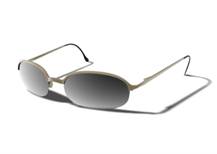 What if someone lied and told you that you had cancer? And the only way to get rid of it would be to buy a pair of really strong sunglasses (stay with me, there’s a point). And then you found out later that the only reason you had the sunglasses was because that someone wanted to make a sale and not because you had cancer. And then you found out that the sunglasses actually made your vision worse. Would you be mad? Now think about what else you are being sold everyday. What if someone lied and told you that you had cancer? And the only way to get rid of it would be to buy a pair of really strong sunglasses (stay with me, there’s a point). And then you found out later that the only reason you had the sunglasses was because that someone wanted to make a sale and not because you had cancer. And then you found out that the sunglasses actually made your vision worse. Would you be mad? Now think about what else you are being sold everyday.
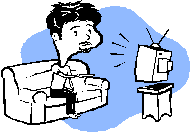 Think back to the last time you were watching TV. Now think about the commercials. I know, I know, you turned the volume down, left the room, or you “just don’t pay attention to commercials”. But the numbers don’t lie, advertising on TV works. According to the Seattle Times, a 30-second spot during the Super Bowl will cost $2.5 million. Companies wouldn’t shell out the dough if it didn’t work. Now think about the latest ad telling you to “ask your doctor about . . .” Think back to the last time you were watching TV. Now think about the commercials. I know, I know, you turned the volume down, left the room, or you “just don’t pay attention to commercials”. But the numbers don’t lie, advertising on TV works. According to the Seattle Times, a 30-second spot during the Super Bowl will cost $2.5 million. Companies wouldn’t shell out the dough if it didn’t work. Now think about the latest ad telling you to “ask your doctor about . . .”
Why are there so many ads about drugs on TV today? A 2002 article in the British Medical Journal (#1 journal in the world) discussed this very issue. The author states that, “Drug companies are engaged in invisible, unregulated attempts to change public perceptions about health and illness in order to widen markets for new drugs. A key strategy is to target the news media with stories designed to create fears about the condition or disease and draw attention to the latest treatment.” What does this mean? Drug companies are using scare tactics to get you to buy their drugs.
Irritable Bowel Syndrome or IBS used to be considered a common functional disorder. With the arrival of new drugs it is now becoming a serious disease. Previously, a drug called Lotronex (made by GlaxoSmithKline), was part of a 3 year “medical educational program”. The idea was to set up an advisory board with material they said was clinically valid, place advertorials in medical journals, and to target other groups such as pharmacists, nurses, and patients. The drug company’s primary interest was shaping public opinion about IBS in a way that would maximize sales of its medication. However, the campaign was cut short after reports to the FDA of serious and sometimes fatal adverse reactions to Lotronex. Bad sunglasses anyone?
This article was put together so that you ask questions. If you have any for us, we’re happy to give you the best answer we can. The information above is yours, the number below is ours.
back to top
Time to Shift
Americans spend over $88 billion a year on prescription and over the counter medicines. Yet we are still 38th on the list of healthy countries. If you spend more money on health, you should be healthier right? Why doesn’t this match up?
 While you’re thinking about that, let’s take a little mental trip. Say you’re driving down the road and your oil light comes on the dashboard. You continue driving for a little while thinking, hoping that it will go away as quickly as it came on. Not realizing, at that moment, that the oil has probably been getting low for many weeks and maybe even months. You begin this conversation with yourself: “I wonder what happened all of a sudden, why now? I just washed the car yesterday, and put in a new air freshener too, and this is how it treats me?” As you continue down the road, you glance down at the light and sure enough it’s still there. Crumbs! Now there’s a little noise along with the light (anyone making a connection to their own health?). So you think, “Maybe I’ll cut the wires to the light (surgery) and that will take care of it”. No, that won’t be good. O.K. you say, “I’ll stop and put some pain medication in . . . I mean oil. That’s better, it must be fixed now that the light went off!” While you’re thinking about that, let’s take a little mental trip. Say you’re driving down the road and your oil light comes on the dashboard. You continue driving for a little while thinking, hoping that it will go away as quickly as it came on. Not realizing, at that moment, that the oil has probably been getting low for many weeks and maybe even months. You begin this conversation with yourself: “I wonder what happened all of a sudden, why now? I just washed the car yesterday, and put in a new air freshener too, and this is how it treats me?” As you continue down the road, you glance down at the light and sure enough it’s still there. Crumbs! Now there’s a little noise along with the light (anyone making a connection to their own health?). So you think, “Maybe I’ll cut the wires to the light (surgery) and that will take care of it”. No, that won’t be good. O.K. you say, “I’ll stop and put some pain medication in . . . I mean oil. That’s better, it must be fixed now that the light went off!”
In that paradigm or way of thinking, have we addressed the solution so as to allow optimum performance and longevity of our vehicle? Or have we merely stopped the noise and made the light go out temporarily? It’s time to shift that paradigm!
Unfortunately, we often treat our bodies worse than our cars! Many times we cover up the underlying cause with medications that do not promote health. We allow the real problem to remain and the illness to progress. Most medicines do nothing to encourage the body’s natural healing ability. We need to think about health care that promotes well-being instead of just treating the symptoms of disease.
Chiropractic promotes the philosophy that health comes from within, that the body is a self-healing, self-regulating organism. Unlike an automobile with replaceable parts, you only get one set of parts and they are intended to last all your life. So prevention and function are paramount! But that means more than keeping the oil light off. It means taking care of all the aspects of health: a properly functioning nervous system, so that the right foods, the best water and the appropriate exercise and stress management can be more effective in promoting wellness in your home. Wellness care doesn’t wait until the oil light comes on.
It’s your body and your choice, it’s our number below!
back to top
Asthma and Allergies
Think about this for a second, if you breathe in a foreign substance that your body doesn’t like (i.e. dust or pollen), what would be a good reaction? Cover the symptoms or remove the stimulus?
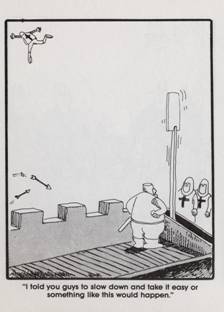 Today there are drugs used to dilate the airways so that the asthmatic can get a good breath. Now this is fine in an emergency, we all know the importance of oxygen, but now the airways are wide open for MORE dust or pollen. Then we figured out that with increased irritation of the airways (because of more dust, etc.) there is more inflammation. This leads to increased scarring which leads to more breathing problems. So another “solution” to the problem was/is to cover up the inflammation with corticosteroids. Today there are drugs used to dilate the airways so that the asthmatic can get a good breath. Now this is fine in an emergency, we all know the importance of oxygen, but now the airways are wide open for MORE dust or pollen. Then we figured out that with increased irritation of the airways (because of more dust, etc.) there is more inflammation. This leads to increased scarring which leads to more breathing problems. So another “solution” to the problem was/is to cover up the inflammation with corticosteroids.
Corticosteroids (like Alvesco) are used to decrease the natural inflammatory response and they can lead to increased body weight, bone loss, stunted growth in children, and altered adrenal function. Plus, the body has the inflammatory response for a reason . . . to get rid of the foreign substance.
So what can we do to help the body take care of the problem? Here is just a short list of vitamins/supplements that you can try.
Antioxidants (to reduce bronchial constriction): Vit. C (at least 1 gram daily), Vit. E (400 IU daily), beta-carotene, and selenium.
Decrease shortness of breath: Vit. B12.
Some children with asthma have been found to have an altered ability to convert tryptophan, leading to constricted bronchioles. It has been found that Vit. B6 (50 mg twice daily) can help with this conversion and relax the airways.
However, you can take all the vitamins you want, but it won’t make a bit of difference if the brain can’t communicate with the lungs. The nerves controlling the lungs must be kept from interference because they control everything from constriction of the airways to the amount of blood available for oxygen. Asthmatics should be checked to see if the vital nerves supplying the lungs are damaged. Adjustments open nerve channels to help the lungs open and close properly.
Do you know anyone who could use this advice? Have them call!
back to top
Lousy Lungs?
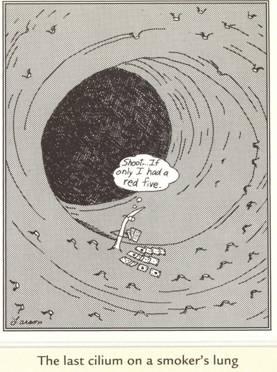 Feeling short of breath? You’re not alone. According to the American Lung Association, approximately 34.1 million Americans suffer from asthma. It’s a big problem that’s been addressed mainly with the use of drugs (corticosteroids) for years, yet according to the CDC: “The prevalence of asthma increased 75% from 1980-1994” and the WHO expects the number to be over 100 million by 2025. Why don’t these drugs fix the problem? Drugs definitely have their place in an emergency, but what about alternative treatments to minimize emergencies? Feeling short of breath? You’re not alone. According to the American Lung Association, approximately 34.1 million Americans suffer from asthma. It’s a big problem that’s been addressed mainly with the use of drugs (corticosteroids) for years, yet according to the CDC: “The prevalence of asthma increased 75% from 1980-1994” and the WHO expects the number to be over 100 million by 2025. Why don’t these drugs fix the problem? Drugs definitely have their place in an emergency, but what about alternative treatments to minimize emergencies?
There are several modalities that have worked, some supported by research and some not. For example, herbal remedies including Butterbur, Dried Ivy, Ginkgo extract, Tylophora indica, French maritime pine bark extract (Pycnogenol ), Indian frankincense (Boswellia serrata), and Choline. These have shown promising results and were even mentioned on the Mayo Clinic’s website (an allopathic site).
Another treatment option is manual therapy of the spine. Why? Remember, when Christopher Reeve (Superman) fell and broke his neck, he lost the ability to breathe on his own. Lungs and the airways leading to them are controlled by nerves, specifically nerves coming out of an area of the spine at the top of the shoulders and upper neck (note: The bronchioles are controlled by T1-6 and the Vagus nerve as it exits the atlanto-occipital joint specifically). These nerves have been shown (as long ago as 1929!) to effect the lung function. So it makes sense that a subluxation (or misalignment) of the spine could affect the nerves that control the airway function.
Remember, proper nerve function requires proper spine function. Do you know someone with asthma? They may benefit from this information!
Centers for Disease Control. Surveillance for Asthma - United States, 1960-1995, MMWR, 1998; 47 (SS-1).
World Health Organization. Global surveillance, prevention and control of chronic respiratory diseases: a comprehensive approach, 2007.
back to top
Safety of Chiropractic
I'm often asked about how safe Chiropractic is, especially in regards to the treatment of children. Rather than give you my biased opinion, let me share what is written in the Patient Safety section of Council on Chiropracitc Practice Clinical Practice Guidelines. That's quite the mouthful, but what it means is this source is the premier authority on Chiropractic safety. The following are some parts of that report.
"[the risk of fatal stroke after cervical manipulation is placed at 0.00025%] According to data obtained from the National Center for Health Statistics, the mortality rate from stroke in the general population was calculated to be 0.00057%. If these data are correct, the risk of a fatal stroke following “cervical manipulation” is less than half the risk of fatal stroke in the general population."
The interesting part of these stats is that the practitioner involved isn't always a chiropractor.
"Terrett observed that “manipulations” administered by Kung Fu practitioner, GPs, osteopaths, physiotherapists, a wife, a blind masseur, and an Indian barber were incorrectly attributed to chiropractors."
The fact of the matter is that there is no evidence that chiropractic is a the cause of strokes.
"The panel found no competent evidence that specific chiropractic adjustments cause strokes."
"Jaskoviak(11) reported that not a single case of vertebral artery stroke occurred in approximately five million cervical “manipulations” at the National College of Chiropractic Clinic from 1965 to 1980."
I only refer to stroke as a complication with Chiropractic simply because it is constantly brought up through sensationalized reports, not based on scientific facts. There are other complications, of which the biggest is stiffness after an adjustment. However, these complications are quite rare.
"Osteopathic authors Vick, et al.(12) reported that from 1923 to 1993, there were only 185 reports of injury associated with “several million treatments.”"
So, to sumarize, is Chiropractic safe? Absolutely.
I have only included quotes from one source here, but if you would like more information on the safety of Chiropractic, please ask! I will be happy to make you a copy.
back to top
Virus-"Killer" Salsa
People often talk about a flu "season" when in actuality we are just getting weakened immune systems. The following recipe is a great one for boosting your immune system with garlic. Try it out today!

-1 avocado
-2 cloves garlic (minced)
-2 cups salsa
-1/2 tsp. Cayenne pepper
-1/2 cup sour cream (optional)
Mix all ingredients together and use with your favorite dipping chips. And it tastes much better than a vaccine! To see a great video on vaccines, click here! Flu Shot
back to top
Indigestion? Heartburn?
A common misconception about stomach issues is that heartburn comes from having too much acid in the stomach. Actually, the normal pH of the stomach is 1.5-3, which is very acidic (Water has a pH of 7, lower numbers mean more acidic). The stomach thrives on an acidic environment. It actually makes the cells happy. That’s why heartburn is typically an issue of having too little acid!
 Now I know that seems opposite of logical, but think about this: If the stomach doesn’t have enough acid, it cannot correctly digest your food. That allows the food to sit in your stomach longer and build up. This leads to less room for the stomach juices, and they get pushed up into the esophagus, giving you the burning sensation. Now I know that seems opposite of logical, but think about this: If the stomach doesn’t have enough acid, it cannot correctly digest your food. That allows the food to sit in your stomach longer and build up. This leads to less room for the stomach juices, and they get pushed up into the esophagus, giving you the burning sensation.
The typical “solution” is taking antacids, thinking this will reduce the burning, and it does. Unfortunately, this further reduces the strength of the acid and leads to chronic digestive problems and chronic heartburn. Ever notice that most people with heartburn continually pop Tums like they’re candy? That’s because the short term “fix” produces long term problems.
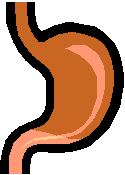 Did you know antacids contain aluminum and lead? These heavy metals build up in the liver, kidneys, and bone. Chronic antacid use is also linked to increased chance of ulcers. When the acid level drops in the stomach, the cells become dysfunctional, and the stomach lining become unhappy. Research is now showing a high correlation between antacid use and ulcers. Did you know antacids contain aluminum and lead? These heavy metals build up in the liver, kidneys, and bone. Chronic antacid use is also linked to increased chance of ulcers. When the acid level drops in the stomach, the cells become dysfunctional, and the stomach lining become unhappy. Research is now showing a high correlation between antacid use and ulcers.
The stomach is often “late to complain”, which means that if you’re having a digestive issue, the problem has been there for a long time. Remember, the problem is usually not too much acid, but too little.
We carry products in the office that increase the function of the stomach, and help restore proper acid balance.
If you are interested in some of our Biotics products for your stomach or simply want to know more information, please ask! The information above is yours, please share it with someone you care about.
back to top
Attention Deficit Disorder
Do you know a child who is easily distracted by outside stimuli? What about a child who blurts out answers to unfinished questions or talks excessively? How about one that fidgets or squirms in his seat? If so, that child may be diagnosed as having Attention Deficit Disorder (ADHD) and be prescribed Ritalin.
ADHD is a so-called "illness" described in the Diagnosis and Statistical Manual of Mental Disorders 111-R (DSM 111-R), the handbook of psychiatry. The "symptoms" described in the DSM-111-R include common forms of childhood activities such as those described above, failing to finish chores, and difficulty waiting turns in games (APA 1987). Ritalin, an amphetamine, is prescribed to "treat" ADHD in children and adults. However, when this drug is prescribed most of the data given to parents about Ritalin is not true. Statements like "Ritalin has no side effects", "Ritalin is not at all addictive", and "Ritalin will help improve your child's performance in school" simply are not true. Ritalin has many dangerous side effects and withdrawal symptoms, it is a highly addictive substance often accompanied by crime (one example of this is the Columbine incident), and, statistically, has not been shown to improve the literacy of schoolchildren. Disorders 111-R (DSM 111-R), the handbook of psychiatry. The "symptoms" described in the DSM-111-R include common forms of childhood activities such as those described above, failing to finish chores, and difficulty waiting turns in games (APA 1987). Ritalin, an amphetamine, is prescribed to "treat" ADHD in children and adults. However, when this drug is prescribed most of the data given to parents about Ritalin is not true. Statements like "Ritalin has no side effects", "Ritalin is not at all addictive", and "Ritalin will help improve your child's performance in school" simply are not true. Ritalin has many dangerous side effects and withdrawal symptoms, it is a highly addictive substance often accompanied by crime (one example of this is the Columbine incident), and, statistically, has not been shown to improve the literacy of schoolchildren.
The manufacturer of Ritalin, CIBA-GEIGY, warns that the drug must not be used on children under the age of six. The long term effects of Ritalin have not been established and the mechanism of how Ritalin works in the body is not understood. There are also many other warnings that should be known about the side effects of Ritalin. Among these are stunting growth, depression, insomnia, nervousness, skin rash, anorexia, nausea, dizziness, headache, abdominal pain, blood pressure, and pulse change, and development of Tourette's syndrome. Tourette's syndrome is a permanent and irreversible condition characterized by body ticks, spasms, barking sounds, and screaming obscenities. Chronic usage of Ritalin is also known to produce psychosis.
In addition to dangerous side effects and withdrawal symptoms, Ritalin is an extremely addictive substance. Under Federal laws, Ritalin is classified as a Schedule 2 Controlled Substance. This rating of Schedule 2 is given to prescription drugs which have the greatest abuse and dependence potential. Other drugs which share this category with Ritalin are morphine, opium, methadone and cocaine. In fact, the DSM-111-R states that "the patterns of use, associated features, and course of Amphetamine Dependence and Abuse are very similar to those of Cocaine Dependence and Abuse." The DSM-111-R goes on to state that experience users of amphetamines and cocaine are unable to distinguish between the two substances. The DSM-111-R continues, "One of the few differences between the two classes of substances is that the psychoactive effects of the amphetamine last longer." Psychiatrists as well as the United States government recognize that Ritalin is an extremely addictive substance, although this is a fact rarely known by parents or users of Ritalin. In a 1988 article titled "Rx Drug Abusers Targeted", the Akron Beacon Journal stated that Ritalin accounted for 80% of drug prescription abuse cases in that area. Reports by law officers in numerous cities across Canada recognized that Ritalin was responsible for more street crime than any other drug in a 1987 article in the Western Report. The article also noted that Ritalin was the street drug of choice all across Canada (Whyte, Gallagher, etc. 1987).
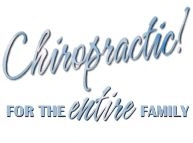 One would think that despite all the harmful side effects, withdrawal symptoms and addictive effects Ritalin would, in fact, help children to perform better in school. However, this has not shown to be true. Despite the drastic increase in Ritalin administration to schoolchildren since its introduction, SAT scores in the United States have dropped rather than increased over the past thirty years. Since 1963, SAT scores steadily declined for sixteen straight years, finally leveling off in the range of 890-900. The former average SAT score in 1963 was a 980 (Citizens Commission on Human Rights, 1993). Ritalin, which is currently administered to thousands of schoolchildren, supposedly improves he performance of schoolchildren. However, the decline of SAT scores and study upon study demonstrate the opposite. One would think that despite all the harmful side effects, withdrawal symptoms and addictive effects Ritalin would, in fact, help children to perform better in school. However, this has not shown to be true. Despite the drastic increase in Ritalin administration to schoolchildren since its introduction, SAT scores in the United States have dropped rather than increased over the past thirty years. Since 1963, SAT scores steadily declined for sixteen straight years, finally leveling off in the range of 890-900. The former average SAT score in 1963 was a 980 (Citizens Commission on Human Rights, 1993). Ritalin, which is currently administered to thousands of schoolchildren, supposedly improves he performance of schoolchildren. However, the decline of SAT scores and study upon study demonstrate the opposite.
No child deserves to be drugged in order to make them conform to someone else's idea of what it is to be "good"; to sit still, to await his/her turn in games, etc. No child deserves to be placed on a drug with such dangerous side effects as Tourette's syndrome and withdrawal symptoms of paranoia and suicide. There are alternatives to the behavior modifying drugging which is occurring to children all across this country. Many successful non-medicinal alternatives to Ritalin exist today. For further information on Ritalin or alternative solutions for handling children diagnosed with ADHD, contact the Citizens Commission on Human Rights at one of the following addresses: 6362 Hollywood Blvd. Suite b, Los Angeles, CA 90028; 1-800-869-CCHR or P.O. Box 1561, Snellville, GA 30278 1-404-518-8868.
-Doctor’s comments: Ritalin is a drug. Let’s not forget that. Unfortunately, it is now treated like vitamins; just something you take as a child and that it’s no big deal. As the above article points out, this is a class 2 drug, which happens to be in the same category as Cocaine and Morphine! This is a drug that is being asked for by teachers who simply want all the children to sit with folded hands and not act like . . . well, children. What it comes down to is asking yourself this question: Does my child have a deficiency in Ritalin? The answer is obvious, but the thing to remember is that as a parent you have MANY options for dealing with a difficult child. Let me be clear: drugs have a place in our society but they should always be a last resort. What we offer in our office is natural alternatives first and can refer for schedule 2 drugs last. If you have any questions about this or anything else, please don’t hesitate to ask.
back to top
Immunity, Ill Nerves, and Ingenious Ideas
Can adjustments of the back help you fight a cold? Sounds silly doesn’t it? But the reality is that your back is the information super highway of your body. The only reason Chiropractors spend so much time finding and correcting problems with the back is because it is where the nerves that control the rest of the body are located. So what would moving spinal joints (back bones) do to your immune system?
According to Dr. Korr “spinal lesions are associated with exaggerated sympathetic activity”. This means, when your spine is “off”, your nervous system is hyper. Your spine literally “gets on your nerves”!
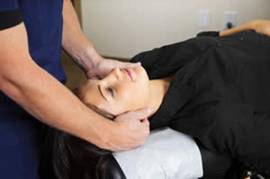 Sympathetic activity (nerves) have been shown to alter immune function. According to Murray, “Sympathetic nerve endings densely innervate lymphoid tissue such as the spleen, lymph nodes and the thymus, and lymphoid cells have beta 2 adregenergic receptors.” So the nerves coming out of the spine control the organs involved in immune response. Sympathetic activity (nerves) have been shown to alter immune function. According to Murray, “Sympathetic nerve endings densely innervate lymphoid tissue such as the spleen, lymph nodes and the thymus, and lymphoid cells have beta 2 adregenergic receptors.” So the nerves coming out of the spine control the organs involved in immune response.
Ronald Pero, Ph.D. (chief of cancer prevention research at New York's Preventive Medicine nstitute and professor of medicine at New York University) measured the immune systems of people under chiropractic care as compared to those in the general population and those with cancer and other serious diseases. In his initial three-year study of 107 individuals who had been under chiropractic care for five years or more, the chiropractic patients were found to have a 200% greater immune competence than people who had not received chiropractic care, and 400% greater immune competence than people with cancer and other serious diseases. The immune system superiority of those under chiropractic care did not diminish with age. Dr. Pero stated:
“When applied in a clinical framework, I have never seen a group other than this chiropractic group to experience a 200% increase over the normal patients. This is why it is so dramatically important. We have never seen such a positive improvement in a group…”
In 1991, Patricia Brennan, Ph.D. and other researchers conducted a study that found improved immune response following chiropractic treatment. Specifically, the study demonstrated the “phagocytic respiratory burst of polymorphnuclear neutrophils (PMN) and monocytes were enhanced in adults that had been adjusted by chiropractors.” In other words, the cells that act like "Pac-Man" eating and destroying bad cells are enhanced through chiropractic care.
Do you think Chiropractic could help your immune system?
Korr IM: "Andrew Taylor Still memorial lecture: Research and Practice - a century later." J Am Osteopathy Assoc 1974 73:362.
Murray DR, Irwin M, Reardon CA, et al. "Sympathetic and immune interactions during dynamic exercise. Mediation via a beta 2 - adrenergic-dependent mechanism." Circulation 1992 86(1): 203
Pero R. "Medical Researcher Excited By CBSRF Project Results." The Chiropractic Journal, August 1989; 32.
Brennan P, Graham M, Triano J, Hondras M. "Enhanced phagocytic cell respiratory bursts induced by spinal manipulation: Potential Role of Substance P." J Manip Physiolog Ther 1991; (14)7:399-400.
back to top
“Every function of the human body is under control of the nervous system” -Grays Anatomy, 29th edition, p. 4
Scoliosis (can it be treated?)
A common misconception about scoliosis is that you either get it or you don’t. If you’re one of the unlucky ones that do, you’re stuck with it. The reality is, there are 2 types of scoliosis: structural (genetic) or non-structural (developmental). Structural scoliosis is caused by diseases, infections, birth defects, etc. and can be supported but not corrected. Developmental scoliosis is due to leg length inequality, muscle spasms, postural imbalance, and nerve dysfunction and can be corrected if caught early. For this discussion, I’ll refer to the second type of scoliosis only. Scoliosis is a REACTION or compensation to a problem that usually starts at the head and neck, NOT only the middle and lower back. Treating only the area of curves in a case of scoliosis is like turning up the heat when all you have to do is close the open window or putting in ear plugs when you can turn the volume down. You get the point. Treating an effect makes no sense if you don’t correct the cause.
Cat research was used to figure out where scoliosis comes from. First, the researchers cut one level of nerves exiting the spine and nothing happened. Then two levels, nothing. But with 3 nerve levels cut, the cats immediately exhibited a scoliotic pattern. What does this mean? In cases of scoliosis, typically you have 3 or more levels of nerve damage in the spine! The great thing is that adjusting and relieving nerve stress can change the scoliosis. Treating the cause!
The following is an example of an 8 year old boy before and after 4 months of care in our office.
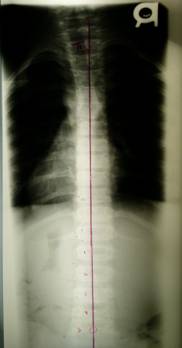 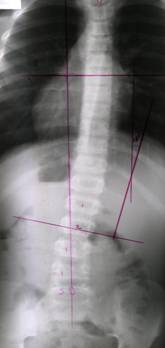
After 4 months of treatment Before
back to top
Splenda and Aspertame: sweet inventions?
Before you use either of these sweeteners, either by adding it to your food or buying food with it already added, you may want to know some things about them.
 As of 2005, only six human trials have been conducted on Splenda (sucralose). Of these six trials, only two of the trials were completed and published before the FDA approved sucralose for human consumption. The two published trials had a grand total of 36 human subjects. Of the 36, only 23 total were actually given sucralose for testing (the rest were controls). Finally, the longest trial at this time only lasted four days and looked at sucralose in relation to tooth decay, not human tolerance. After the FDA approved sucralose, the longest trial lasted 3 months, hardly the length of consumption most Splenda consumers will have. What does this mean for you and me? We are the guinea pigs. As of 2005, only six human trials have been conducted on Splenda (sucralose). Of these six trials, only two of the trials were completed and published before the FDA approved sucralose for human consumption. The two published trials had a grand total of 36 human subjects. Of the 36, only 23 total were actually given sucralose for testing (the rest were controls). Finally, the longest trial at this time only lasted four days and looked at sucralose in relation to tooth decay, not human tolerance. After the FDA approved sucralose, the longest trial lasted 3 months, hardly the length of consumption most Splenda consumers will have. What does this mean for you and me? We are the guinea pigs.
Between 2000 and 2004, the percentage of US households using Splenda products jumped form 3 to 20 percent. In a one year period, Splenda sales topped $177 million. What does this mean? There are a lot of guinea pigs out there.
 What about Aspartame? Aspartame, found in many products like Nutra Sweet and Equal is so toxic it has several websites dedicated to its adverse effects (www.dorway.com, www.holisticmed.com/aspartame). The problem with aspartame is that 10% of it is methanol, which converts to formaldehyde in the body and then to formic acid (formic acid is the poison found in fire ant stings). This in turn causes metabolic acidosis. The list of diseases being linked to aspartame is growing and already includes: M.S., Lupus, Fibromyalgia, Diabetes, Manic Depression, and Brain Tumors. What about Aspartame? Aspartame, found in many products like Nutra Sweet and Equal is so toxic it has several websites dedicated to its adverse effects (www.dorway.com, www.holisticmed.com/aspartame). The problem with aspartame is that 10% of it is methanol, which converts to formaldehyde in the body and then to formic acid (formic acid is the poison found in fire ant stings). This in turn causes metabolic acidosis. The list of diseases being linked to aspartame is growing and already includes: M.S., Lupus, Fibromyalgia, Diabetes, Manic Depression, and Brain Tumors.
“But the FDA approved it!” Yes, but the FDA also approved Celebrex and Vioxx (studies showed patients who took it for more than 18 months had double the risk of heart attack and stroke). There will be lawsuits on these two drugs for years to come. Just because something is approved by government, doesn’t mean it’s right for your body.
 So what do you do as a person who wants to eat sweets? Simple, choose natural sources of sugar like cane sugar (www.sugarintheraw.com). Your body recognizes natural products and absorbs them better. No matter what you hear, Splenda is not a natural sugar (It is made in a lab using chlorine). When the body can’t recognize a substance it will remove it (through vomiting or diarrhea) or it will rot in the gut. This rotting will decrease the function of your body and limit your overall health. Our goal in the office is to release your inner health potential and your body can’t do this with the wrong nutrition. Consider this food for thought. So what do you do as a person who wants to eat sweets? Simple, choose natural sources of sugar like cane sugar (www.sugarintheraw.com). Your body recognizes natural products and absorbs them better. No matter what you hear, Splenda is not a natural sugar (It is made in a lab using chlorine). When the body can’t recognize a substance it will remove it (through vomiting or diarrhea) or it will rot in the gut. This rotting will decrease the function of your body and limit your overall health. Our goal in the office is to release your inner health potential and your body can’t do this with the wrong nutrition. Consider this food for thought.
back to top
When our nation is focused on health achievement, rather than disease treatment, the total cost of providing medical care would dramatically decline, because healthy people require less medical resources.
-Dr. Mercola (M.D.)
At What Age?
I’ve often been asked: when is the right time to see a Chiropractor? When I’m old? Young? At birth? When I hurt? When I feel good? I’ll answer that in a minute, but let’s first take a look at some recent research.
 A study involving a review of a database collected during a randomized clinical trial of a comprehensive geriatric program (info pulled from a study on senior citizens) found that: “chiropractic patients in this population were less likely to have been hospitalized, less likely to have used a nursing home, more likely to report a better health status, be mobile, and exercise vigorously. Furthermore, they were less likely to use prescription drugs.” Seniors? Yes. A study involving a review of a database collected during a randomized clinical trial of a comprehensive geriatric program (info pulled from a study on senior citizens) found that: “chiropractic patients in this population were less likely to have been hospitalized, less likely to have used a nursing home, more likely to report a better health status, be mobile, and exercise vigorously. Furthermore, they were less likely to use prescription drugs.” Seniors? Yes.
According to Biedermann, a “wide range of pediatric symptomatology may result from suboccipital strain” (including fevers, sleep disorders, muscle spasms, and abnormal posture). Plain English: kids with upper neck problems can have a wide range of symptoms. Young? Yes.
According to G. Guttman M.D., approximately 80% of babies examined at birth suffer from subluxations (spinal misalignments). At birth? Yep.
According to Orthopedists, “Chiropractic is the only proven effective treatment in chronic cases of whiplash.” Also, according to the New England Journal of Medicine, “97% of spinal pain is mechanical in nature.” Since Chiropractic is mechanical in nature, doesn’t is make sense that a mechanical approach would help a mechanical problem? When you hurt? Yes. proven effective treatment in chronic cases of whiplash.” Also, according to the New England Journal of Medicine, “97% of spinal pain is mechanical in nature.” Since Chiropractic is mechanical in nature, doesn’t is make sense that a mechanical approach would help a mechanical problem? When you hurt? Yes.
As the leading treatment in health and wellness, patients seek out Chiropractic when they feel good because they want to stay that way. It’s the prevention side of Chirorpactic.
So, from what age should you see a Chiropractor? From diapers to diapers! The research says any time is a good time to receive a healthy adjustment from a chiropractor!
Coulter I, et al. Chiropractic patients in a comprehensive home-based geriatric assessment, follow-up and health promotion program. Topics in Clinical Chiropractic 1996; 3(2): 46-55.
Biedermann H. Kinematic imbalances due to suboccipital strain in newborns. Manual Medicine 1992; 6:151.
Guttman G. Blocked atlantal nerve syndrome in infants and small children. Manuelle Medizin, Springer-Verlag, 1987.
Khan, S, J Orthpaedic Med. 1999; 21(1): 22-25. A symptomatic classification of whiplash injury and the implications for treatment.
Deyo, MD, NEJM. 2001; 344(5): 363-369. Differential Diagnosis of Low Back Pain.
back to top
The Only Proven Treatment of Whiplash
“I’ve been in a car accident, do you think chiropractic can help me?” Yes, here’s why! In most accidents there is damage to the metal structure of the car. The question is: if there is enough force to bend metal, could that same force injure the body which is made up mostly of soft tissues? Yes, and usually the damage is a mechanical change (aka joint dysfunction). According to a 2001 article in the New England Journal of Medicine, 97% of spinal pain is mechanical in nature. So here’s another question: If the damage is mechanical in nature, should you receive a mechanical treatment or use chemicals (i.e. pain killers, meds) to fix the problem? A mechanical problem requires a mechanical solution, right? Chiropractors are specially trained to analyze damaged joints and correct the problems caused by the accident. According to the surgical journal, the Journal of Orthopaedic Medicine, “Chiropractic is the only proven effective treatment in chronic cases of whiplash”. (emphasis mine) The beauty of this article is that it is un-biased being from Orthopedists. So to make a long answer short: YES!!!, Chiropractic can help you if you’ve been in an accident.
Deyo, MD, NEJM. 2001; 344(5): 363-369. Differential Diagnosis of Low Back Pain.
Khan, S, J Orthpaedic Med. 1999; 21(1): 22-25. A symptomatic classification of whiplash injury and the implications for treatment.
back to top
Studies on Chiropractic
The literature is replete with examples of how Chiropractic is beneficial for a wide range of health problems. The following is just a sampling of some of the landmark studies that everyone should read (especially those who still doubt what Chiropractic can do).
U.S. Government Agency Report
1994 study published by the U.S. Agency for Health Care Policy and Research (AHCPR) and the U.S. Department of Health and Human Services endorses spinal manipulation for acute low back pain in adults in its Clinical Practice Guideline #14. An independent multidisciplinary panel of private-sector clinicians and other experts convened and developed specific statements on appropriate health care of acute low back problems in adults. One statement cited, relief of discomfort (low back pain) can be accomplished most safely with spinal manipulation, and/or nonprescription medication.
The Manga Report
A major study to assess the most appropriate use of available health care resources was reported in 1993. This was an outcomes study funded by the Ontario Ministry of Health and conducted in hopes of sharing information about ways to reduce the incidence of work-related injuries and to address cost-effective ways to rehabilitate disabled and injured workers. The study was conducted by three health economists led by University of Ottawa Professor Pran Manga, Ph.D. The report of the study is commonly call the Manga Report. The Manga Report overwhelmingly supported the efficacy, safety, scientific validity, and cost-effectiveness of chiropractic for low back pain. Additionally, it found that higher patient satisfaction levels were associated with chiropractic care than with medical treatment alternatives. “Evidence from Canada and other countries suggest potential savings of hundreds of millions annually,” the Manga Reports states. “The literature clearly and consistently shows that the major savings from chiropractic management come from fewer and lower costs of auxiliary services, fewer hospitalizations, and a highly significant reduction in chronic problems, as well as in levels and duration of disability.
Rand Study on Low Back Pain
A four-phase study conducted in the early 1900s by RAND, one of America’s most prestigious centers for research in public policy, science and technology, explored many indications of low back pain. In the RAND studies, an expert panel of researchers, including medical doctors and doctors of chiropractic, found that:
—chiropractors deliver a substantial amount of health care to the U.S. population.
—spinal manipulation is of benefit to some patients with acute low back pain.
The RAND reports marked the first time that representatives of the medical community went on record stating that spinal manipulation is an appropriate treatment for certain low back pain conditions.
Florida Workers' Compensation Study
A 1988 study of 10,652 Florida workers’ compensation cases was conducted by Steve Wolk Ph.D., and reported by the Foundation for Chiropractic Education and Research. It was concluded that “a claimant with a back related injury, when initially treated by a chiropractor versus a medical doctor, is less likely to become temporarily disabled, or if disabled, remains disabled for a shorter period of time; and claimants treated by medical doctors were hospitalized at a much higher rate than claimants treated by chiropractors.”
Patient Disability Comparison
A 1992 article in the Journal of Family Practice reported a study by D.C. Cherkin, Ph.D., which compared patients of family physicians and of chiropractors. The article stated, “the number of days of disability for patients seen by family physicians was significantly higher (mean 39.7) than for patients managed by chiropractors (mean 10.8).” A related editorial in the same issue referred to risks of complications from lumbar manipulation as being “very low.”
2003 British Medical Journal Report
In the April 26 issue of the British Medical Journal, a study was published that proved manual therapy is a cost-effective method for relieving neck pain. The study found that: "Manual therapy is more effective and less costly than physiotherapy or care by a general practitioner for treating neck pain. Korthals de Bos and colleagues conducted an economic evaluation comparing the cost effectiveness of three different treatments for patients with neck pain. After 26 weeks, patients having manual therapy had higher recovery rates than those having physiotherapy or being cared for by a general practitioner, but these rates were similar after 52 weeks. Total costs in the manual therapy group were around a third of the costs in the other two groups."
1990 British Medical Journal Report
A study conducted by T.W. Meade, a medical doctor, and reported in the June 2, 1990, British Medical Journal concluded after two years of patient monitoring, “for patients with low back pain in whom manipulation is not contraindicated, chiropractic almost certainly confers worthwhile, long term benefit in comparison with hospital outpatient management.”
Landmark Legal Decision Supports Chiropractic
Further validation of chiropractic care evolved from an antitrust suit which was filed by four members of the chiropractic profession against the American Medical Association (AMA) and a number of other health care organizations in the U.S. (Wilk et al v. AMA et al, 1990). Following 11 years of litigation, a federal appellate court judge upheld a ruling by U.S. District Court Judge Susan Getzendanner that the AMA had engaged in a “lengthy, systematic, successful and unlawful boycott” designed to restrict cooperation between MDs and chiropractors in order to eliminate the profession of chiropractic as a competitor in the U.S. health care system. Judge Getzendanner rejected AMA’s patient care defense, and cited scientific studies which implied that “chiropractic care was twice as effective as medical care in relieving many painful conditions of the neck and back as well as related musculo-skeletal problems.” Since the court’s finding and conclusions were released, an increasing number of medical doctors, hospitals, and health care organizations in the U.S. have begun to include the services of chiropractors.
back to top
Sinusitis
Ever wondered why people get sinus infections? A sinus is a space that lightens the head, 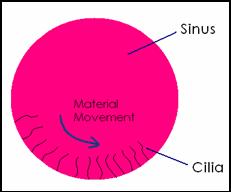 warms air, and produces a certain resonance in your voice. Ever notice that your voice drops when your sinuses get congested? They are also a place where bacteria and viruses are stored during an infection of the body (not just the sinuses themselves). So how do you pump out the “bad stuff” from an infection? They’re called cilia. Cilia are hair-like projections that line sinuses and lungs and wave quickly to push the “gunk” out of the sinus (like a big broom). These cilia are also in the throat and are what help you to get rid of mucous during a sore throat. So what controls the cilia? Nerves from the brain stem and spinal cord. warms air, and produces a certain resonance in your voice. Ever notice that your voice drops when your sinuses get congested? They are also a place where bacteria and viruses are stored during an infection of the body (not just the sinuses themselves). So how do you pump out the “bad stuff” from an infection? They’re called cilia. Cilia are hair-like projections that line sinuses and lungs and wave quickly to push the “gunk” out of the sinus (like a big broom). These cilia are also in the throat and are what help you to get rid of mucous during a sore throat. So what controls the cilia? Nerves from the brain stem and spinal cord.
Now there are two parts to your nervous system: the sympathetic and the parasympathetic systems. These are like the gas and brakes of your car; one makes you go faster, one slows you down. The part that makes the cilia go faster in the sinus comes from the spinal cord (Specifically, the area where the neck meets the shoulders, T1-3, see figure below).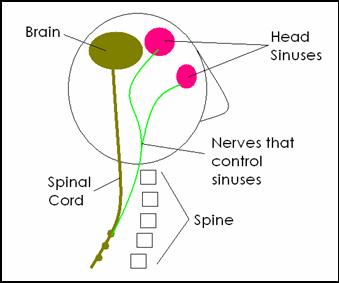 Can you imagine if you damaged this part of the spine, for example, getting in a whiplash accident? Would the nerves control the cilia in the sinus properly? No! So the cilia would not push the “gunk” out and the infection would remain or even lead to further infections. Can you imagine if you damaged this part of the spine, for example, getting in a whiplash accident? Would the nerves control the cilia in the sinus properly? No! So the cilia would not push the “gunk” out and the infection would remain or even lead to further infections.
So what do you do? One way to boost your immunity is by eating leafy greens or getting lots of garlic. A great way to do this is by eating what we call Virus-"Killing" Salsa. The other thing to do is make sure the nerves to the sinuses are allowed to work properly. This is exactly what chiropractic is all about. If you have any questions about this or any other health topic, please ask! And remember, to stay healthy is to stay adjusted!
back to top
Children and Car Accidents: What do they do?
Children are often viewed as flexible, pliable, and able to “bounce back” from anything. However, more and more research shows that this simply isn’t the case. The reality is, that Newton’s 3rd law of motion is true (for every action there is an equal and opposite reaction). The forces that kids are exposed to have an effect on their bodies, whether or not they complain of pain. Let’s look at the science:
According to Orenstein, et al, 67% of children reporting to a children’s hospital with cervical (neck) pain had been in a motor vehicle crash. The authors noted that younger children sustained more severe injuries than older children.
Glass, et al, found that: “Children involved in motor vehicle crashes are at high risk for lumbar spine injuries . . . Lumbar spine radiographs are necessary in all cases with suspected lumbar spine injury . . .”. This means that kids in car accidents have a high chance of injury to the low back and that taking x-rays is recommended. This paper underscores the need to evaluate the entire spine in cases of motor vehicle accidents, not just the neck.
According to Hill, et al, 31% of the pediatric neck injuries reviewed were the result of motor vehicle accidents. In younger children (under 8 years of age) subluxation was seen more frequently than fracture. This paper shows an important problem with the typical treatment protocol in hospitals. In taking x-rays of a car accident case, the first thing evaluated is fractures (as it should). But if there aren’t any, the case is typically classified as a “strain” and a “wait and see” approach is taken. The problem, as this paper shows, is that subluxations (or misalignments of the spine) are often missed with this protocol.
Also, a chemical in adult spines known as Tumor Nucrosis Factor (TNF) is a major factor in pain response. This is a chemical, that for the most part, is absent in children. What does this mean? Kids in trauma typically feel less pain from an injury, and often when they do, they are unsure of how to communicate the pain.
In a report by Agran, it was stated that noncrash vehicular events (sudden stops, swerves, turns, etc.) may cause injuries to children as well. This is exactly why we feel it is important to check all children for subluxation, regardless of history.
Children and cars equal a high probability for injury. Examining them early means early correction and fewer long term issues.
1. Orenstein JB, Klein BL, Gotschall CS, et al: "Age and outcome in pediatric cervical spine injury: 11-year experience." Pediatr Emerg Care (1994 Jun) 10(3):132.
2. Glass RB, Sivit CJ, Sturm PF, et al: Lumbar spine injury in a pediatric population: difficulties with computed tomographic diagnosis. J Trauma (1994 Nov) 37(5):815.
3. Hill SA, Miller CA, Kosnik EJ, Hunt WE: "Pediatric neck injuries. A clinical study." J Neurosurg (1984 Apr) 60(4):700.
4. Agran PF: "Motor vehicle occupant injuries in noncrash events." Pediatrics (1981 Jun) 67(6):838.
back to top
Once you go . . .
Do you brush your teeth? Are you planning to for the rest of your life? How come that after brushing your teeth yesterday, you’ll likely brush your teeth today, tomorrow and next week?
Is it because your teeth hurt? Will you brush your teeth because you h ave a cavity? Will you brush your teeth because the accumulated plaque is irritating your gums? ave a cavity? Will you brush your teeth because the accumulated plaque is irritating your gums?
Probably not, because it’s a habit you’ve developed. One of the good, healthy habits. Maybe you like how your mouth feels after brushing. Or you want to avoid painful visits to your dentist. Or you want to prevent bad breath and stains. Or maybe its just because your mom told you to!
Even with this daily maintenance and prevention you’ll probably visit your dentist from time to time. Yet no one ever says, “Once you go to a dentist, you have to go for the rest of your life.” This phrase is often uttered by those who don’t fully understand the preventive nature of chiropractic.
If others could detect your diminished performance, your low energy and your lack of vitality caused by nerve disturbances along your spine in the same way they could see stains on your teeth, regular chiropractic checkups would be more widely embraced.
For most of us, we will experience continued physical, emotional, and chemical stresses for the rest of our lives. At Camp Chiropractic, we are committed to detecting and reducing the effects of these stresses to your spine and nervous system. And we won’t even ask you to spit!
back to top
Masha and Dasha
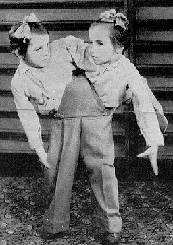 What can conjoined twins teach us about germs? Well, conjoined or “Siamese” twins are joined and often share organs and other body parts. In the case of Masha and Dasha, conjoined twins born in January of 1950, they had two legs (there was a third smaller leg), shared lower intestine, bladder, reproductive organs, and circulatory system. They had separate upper intestines and upper torsos (four arms, two hearts, two heads, etc.). Because they shared circulation, if one twin had a bacterium or virus soon the other twin would have the same invader. But surprisingly, illness affected them each differently. “I don’t like it when we are treated as one person”, said Masha in an interview, “We have one medical record for us but we have completely different illnesses.” Dasha was short-sighted and prone to colds, yet Masha had higher blood pressure with better eyesight. What can conjoined twins teach us about germs? Well, conjoined or “Siamese” twins are joined and often share organs and other body parts. In the case of Masha and Dasha, conjoined twins born in January of 1950, they had two legs (there was a third smaller leg), shared lower intestine, bladder, reproductive organs, and circulatory system. They had separate upper intestines and upper torsos (four arms, two hearts, two heads, etc.). Because they shared circulation, if one twin had a bacterium or virus soon the other twin would have the same invader. But surprisingly, illness affected them each differently. “I don’t like it when we are treated as one person”, said Masha in an interview, “We have one medical record for us but we have completely different illnesses.” Dasha was short-sighted and prone to colds, yet Masha had higher blood pressure with better eyesight.
How can this be? Why did one get the measles as a child while the other didn’t? Evidently there is more to “getting the measles” than having the measles “bug”. This phenomenon was seen over and over with the girls from colds to the flu. Why? Or better yet, have you ever noticed that some kids in school get every sickness “going around” yet others in the same room never “catch it”?
Going back to the twins, the biggest difference between them was that they had separate spinal columns and skulls containing separate spinal cords and brains. It seems as though nature set up the perfect experiment. Think on this: they shared identical DNA, genes, blood, etc. They had to be exposed to the same environment. So the primary difference of how they (and we) respond to infections lies in the function of the nervous system.
Chiropractic has long been shown to increase a person’s immunity (through the nervous system) and is something we see on a daily basis. Make sure to have you and your families’ spines checked on a regular basis and you too can experience greater levels of health.
I’ll leave you with a question: Knowing that your immune system can respond separate from genetics and environment; does it make sense to use something from the outside like a shot or drug to change your immune system? Or change something on the inside like your nervous system which regulates your immune response?
back to top
|

